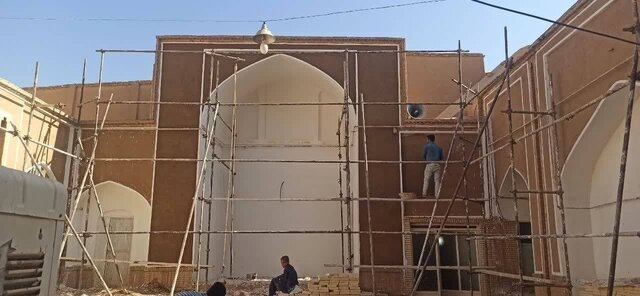Centuries-old mosque in Yazd gains former glory

TEHRAN –A restoration project on the centuries-old Sarpolak Mosque in central Yazd province, has come to an end, a local tourism official has said.
The project involved strengthening the structure, repairing the damaged parts, restoring its walls and flooring, Mohammadreza falahati said on Friday.
The structure, which has been inscribed on the national heritage list, is one of the unique historical monuments in the region, the official added.
In July 2017, the historical core of Yazd was named a UNESCO World Heritage. Wedged between the northern Dasht-e Kavir and the southern Dasht-e Lut on a flat plain, the ancient city enjoys a very harmonious public-religious architecture that dates from different eras.
Yazd is regularly referred to as a delightful place to stay, or a “don't miss” destination by almost all of its visitors. The city is full of mudbrick houses that are equipped with innovative badgirs (wind catchers), atmospheric alleyways, and many Islamic and Iranian monuments that shape its eye-catching city landscape.
Some say it is a living testimony to the intelligent use of limited available resources in the desert for survival. Water is brought to the city by the qanat system. Each district of the city is built on a qanat and has a communal center.
Furthermore, the use of earth in buildings includes walls and roofs through the construction of vaults and domes. Houses are built with courtyards below ground level, serving underground areas. Wind-catchers, courtyards, and thick earthen walls create a pleasant microclimate.
The historical core of Yazd is chockfull of mudbrick houses, bazaars, public bathhouses, water cisterns, mosques, synagogues, Zoroastrian temples, and the historical gardens.
From the divine point of view, the city enjoys the peaceful coexistence of three religions: Islam, Judaism, and Zoroastrianism.
Furthermore, Yazd is home to numerous qanats which have supplied water to agricultural and permanent settlements for thousands of years. The man-carved underground qanat system, in fact, relies on snow-fed streams flowing down the foothills of surrounding mountains.
The earliest water supply to Yazd is estimated to date from the Sassanid era (224 to 651 CE). However, many others have been continually repaired and used over time, and most surviving Ab-Anbars (traditional mudbrick cisterns) can be today traced to the late Safavid and Qajar periods.
SAB/
Leave a Comment